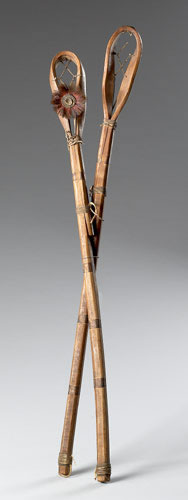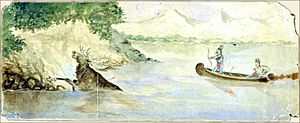Native American recreational activities facts for kids
Early Native Americans loved to play! They had many different sports, card games, and fun activities. They invented these games using things they found in nature. Most of what we know about these games comes from observations made in the early 1700s.
Many American tribes enjoyed athletic contests. These included groups like the Algonquian, Cherokee, Iroquoian, Sioux, Lakota, Choctaw, and Great Lakes peoples. Popular sports were stickball (an early form of lacrosse), chunkey, archery, darts, foot races, and canoeing. Card and dice games were also common, especially among the Iroquois and Lakota. Some of these ancient games even influenced modern sports like lacrosse and casino games. Some games were unique to certain tribes. For example, the Iroquoian people often played the Bowl Game with colored balls and sticks.
Contents
Why Games Were Important
Games and sports were played for many reasons. They were part of religious beliefs, politics, and even used for betting. Games could help solve arguments, offer healing, decide land use, or simply provide entertainment. For instance, in 1639, some tribes used a Huron dice game to help heal sick people.
Native Americans often played games to bring good luck, like rain or good harvests. They also believed games could scare away evil spirits or bring people together. Some games were made for children. These games taught important skills like hand-eye coordination, discipline, and the value of hard work and respect. Other activities were just for adults.
Games like stickball were very physical, and players often got hurt. Yet, it was one of the most popular sports. Many tribes played against each other to settle disagreements. This helped avoid actual wars.
Fun Activities and Sports
Stickball: The "Little Brother of War"
Stickball is a very famous sport among early American tribes. It is the game that modern-day lacrosse came from. Early stickball games had very few rules and no clear boundaries. Sometimes, it was even played as part of a war between two villages.
Players used sticks with nets at the top to catch and pass a ball. Teams won by throwing the ball into a goal as many times as possible. These games could last for several days. They were played in huge open fields between the villages. Goals could be from 500 yards to several miles apart! As many as 100 to 10,000 men might play at once. The Cherokee and Choctaw people were known for playing stickball in the 1700s. Today, many tribes still play the game with similar rules. These include the Muscogee, Seminole, Yuchi, and Natchez.
Chunkey: A Game of Skill
American Indians in the Mississippi Valley, like the Bayogoulas and Choctaw people, played a game called “chunkey” in the early 1700s. This game was important for spiritual and political reasons. In Mississippi, men usually played stickball, while women often played chunkey.
Chunkey was a two-person game. Players threw long, spear-like poles (8–15 feet long) at rolling hoops. Other versions of the game were seen across the country. In the 1770s, the Choctaw people played chunkey with round stones or disks. They used a special clay field at least two hundred feet long. An Englishman named James Adair lived with the Chickasaws in the mid-1700s. He noted that chunkey stones were very valuable. They were passed down through families and kept safe between games.
Archery: Aiming for the Target
Archery was one of the earliest games played by Native Americans. The goal was to hit a target or an animal. Records of Indians playing archery go back to AD 250. The Algonquian and Iroquoian tribes, near modern-day Michigan, made their bows from local materials. They often used strong woods like hickory, black locust, ash, elm, and ironwood. Bows were usually long to make them easier to use.
Arrowheads were made from many materials, including antler, copper, and wood. Stone arrowheads were the most desired. They were much stronger and more effective. Another game, called bows and arrows, was popular in the Great Plains. In this game, an arrow was placed on the ground. Players tried to shoot their own arrow across it. The winner took home all the other arrows.
Gambling: Betting on Games
Gambling has a long history among Native Americans. Tribes would bet their horses, food, and other personal items on games like chunkey and stickball. Many games, including dice games and archery, always had bets placed on their outcomes. Betting became a big part of the culture for several tribes.
Martin Rizzo wrote in his book Prehistoric Games of North American Indians. He explained that gamblers sometimes bet themselves into slavery. Later, slave owners among tribes would even bet their slaves. Among the people of the Upper Columbia River, gamblers sometimes lost family members, like wives and children, through their bets. This early betting is often seen as a reason why many American Indians today enjoy gambling, just like their ancestors.
Canoeing: Races on Water
Canoes were more than just a way to travel for some Native American tribes. Their design and use were also inspired by indigenous religious beliefs. Explorers like Samuel de Champlain saw these boats as early as 1603. Native canoes were strong and handmade from carved tree bark. Natives in the Northeast United States in the 1700s used canoes for fishing. They even shot bows and arrows from them.
Rowing contests were a common athletic event among American tribes. Kayaks, which are shorter versions of canoes (usually 10–28 feet long), were used to tow animals caught during hunting.
Regional Games
"Pass the Stone": A Guessing Game
“Pass the Stone” is a simple guessing game. It is still used today to teach children about Native American culture. Two different colored balls are passed around a circle. Children close their eyes and guess what color ball they received. If they guess correctly, they stay in the circle. If they guess wrong, they leave the circle.
Other Unique Games
Not all games were played by everyone. The "ring the stick game" helped with hand-eye coordination. Players used a stick with a ring tied to the bottom. They would throw the ring in the air and try to catch it on the stick.
The "butterfly hide-and-seek game" was a quiet version of hide-and-seek. The seeker would sing “Butterfly, butterfly, show me where to go.” Then, they would silently look for the hiding players.
The "moccasin game" was played by two teams. They used four moccasins and one stone. One team would hide the stone in one of their moccasins while the other team wasn't looking. Then, the other team tried to find the moccasin with the stone.
The "sep game" was a way to help children fall asleep. After singing some songs, the leader would say “sep.” This told the children to be quiet and go to sleep until the next day.
Games of Chance vs. Skill
Games of Chance
Native American games were often divided into those won by chance or by skill. The three most common games of chance were dice games, hand games, and the bowl game. Dice games were much like today's dice games. People rolled dice until they reached a certain number.
The hand game was popular because different tribes could play it, even if they spoke different languages. One person would hold an object and pass it between their hands. The other person would try to guess which hand the object was in.
The bowl game used six nuts with two different colors. If the bowl was hit on the ground and five nuts landed on the same color, one team or player got a point. The team with the most points won. With some betting, these games could last a long time, depending on how competitive the players were.
Games of Skill
Many more games required skill, or dexterity. These included bows and arrows, snow snake, hoop and pole, and various games involving a ball and running.
Snow snake had to be played in winter. Players gathered rocks, sticks, and other items. Each player would slide their object towards a target. The object that got closest to the target won.
The hoop and pole game involved two opponents. Each tried to hit a target hoop with their pole. The person who hit the hoop won. If both hit or both missed, they would try again. Other skill games included early lacrosse and different foot races.
The Role of Women in Native American Recreation
Some Native American games were mainly for men. However, women still played a big part in the fun and entertainment of Native tribes. It was common for Native American women to compete in races, juggling, Choctaw stickball, double ball games, and basketball.
Women often carved the spears and arrowheads used for archery contests and other sports. Professor Fabrice Delsahut and Thierry Terret wrote about how North American Indian women participated in and helped create Native games. Since foot races were mostly for men, Indian women held their own races. They organized these races in valleys, away from the main tribal areas.
Ball games like the “double ball game” were invented just for women. This game was played throughout the Southwest in the early 1700s. In the double ball game, players had to catch two deerskin bags tied together with a leather strap. They used a forked branch or two pieces of wood. They would pass the bags from one player to another, moving them towards the opponents’ goal. Other sports like swimming and wrestling were also played by Kutchin, Mandan, and Manataree women.



